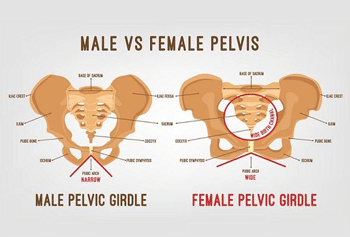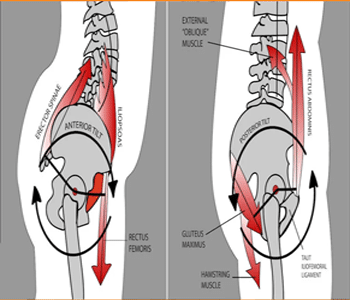The Lower Cross Syndrome as for the Upper Cross Syndrome is an unbalance between the forces of muscle groups that cross each other between the anterior and posterior of the body.
For Lower Cross Syndrome, we look into the Pelvic area.
The pelvis’s role
The pelvis acts as a hinge between the upper and lower limbs.
It is made from a group of bones, ilium, ischium, sacrum, and coccyx interconnected by ligaments.
The pelvis is constantly under the force of pressure or force of pull, which either comes from the upper limb or the lower limb muscle group.
Said so, we have to point out that, between women and men there is a difference in pelvic shape.
The women have a more rounded girdle than men, this is obviously for evolutionary reasons, due to the fact the woman gives birth.

Furthermore for a woman is more common to have a wider range for Anterior pelvic tilt.
For Women is acceptable an anterior pelvic tilt between 1 and 2 cm, wherein man it should be up to 1cm.
This is because of the girdle shape.
In fact, when we look into the pelvic level from the side point of view, we expect to find an anterior pelvis tilt, that doesn’t take over the parameters mentioned above.
This anterior pelvis position, allows the lumbar spine to be slightly arched, so that it can better take the pressure, without the risk to create injury to the lower back.
How to measure the A or P pelvic tilt?
To do so we look sidewise at the difference in high between the ASIS (Anterior Superior Illica spine) and the PSIS (Posterior Superior Illiac Spine).
As the L and R sides of the pelvis are independent of one another one, we can find a dissociation in the tilt of the opposite side. That means that L can be anteriorly tilted and R. posteriorly tilt, or vice versa.
Moving on, now we can analyze what muscles are involved in Lower Cross Syndrome.
For an Anterior Pelvic tilt, we look into tensions for this group of muscles:
- Erector spinae group
- Iliopsoas muscles
- Rectus Femoris
Are you struggling with pain and or body ache? Book now your next massage appointment, at North Fitzroy clinic.
For a Posterior Pelvic Tilt, we look into tensions for this other group of muscles:
- Gluteus Max
- Hamstring
- Rectus Abdominus
- External Oblique
As one or the other group of muscles is tense, the other one as consequence would be weaker.
For example, a person that drives for long hours, or an office worker would commonly suffer from an Anterior Pelvic tilt from Lower Cross Syndrome.
That’s because their Psoas is in constantly forced contraction (hip flexor) and the hamstrings are constantly weakened from the long seating hours.
So when I treat someone with Thai Massage, before the treatment I always make sure to analyze the pelvis level.
This would instantly give me an idea of the balance and unbalance that the person eventually suffers from.
The work that I would do for this type of dysfunction involved the relative muscles, mentioned above, but not only.
During the Thai Massage, as the client lying on a side position, to access areas like the back and or gluteus, I would also work on the client’s shoulders.
If initially, I would not work on the shoulders, after a few minutes the client will find discomfort in the area.
What I like about this Thai Massage technique, is that is not demanding on my body and give me a wider range of access to the client’s body.
Because I can use my feet, knees, elbows, and hands to give a massage, I can freely change the type of pressure to the client’s needs.
Whereas if I was working with a Remedial Massage, the limitations are broader.
Working with a table would make it much harder to access certain body muscles.
Furthermore, it would be hard if not impossible to use feet or knees for massaging.
Giovanni La Rocca
Giovanni moved to Melbourne, Australia, from Italy in 2008 and became a citizen in 2017. He started studying massage therapy in 2016, then completed a Bachelor of Health Science in Clinical Myotherapy in August 2024. During those years, he also specialised in Thai Massage and Manual Lymphatic Drainage for presentations like Lipedema and Lymphoedema. Nowadays, he runs his clinic in Fitzroy North, Melbourne, where he integrates movement therapy into his practice to enhance overall well-being. He also values meditation, having completed several Vipassana courses. Committed to continuous learning, he aims to share his expertise in integrated therapies to help others achieve balance and resilience.